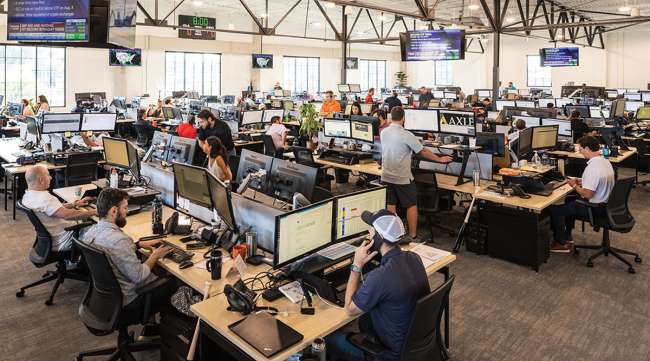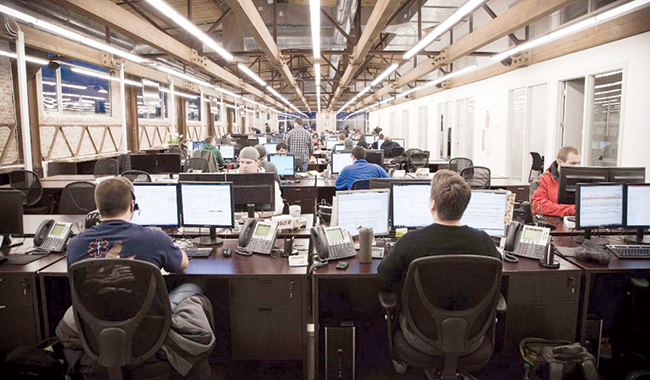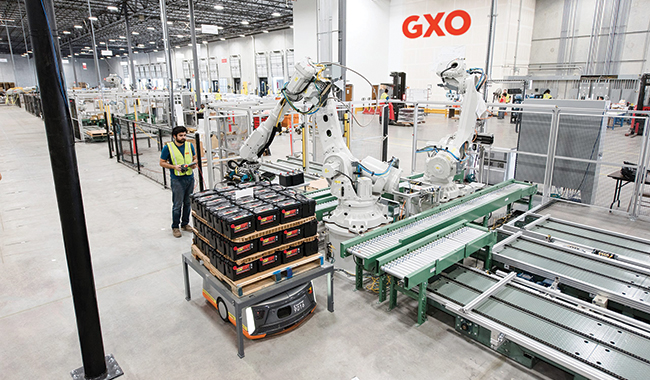Managing Editor, Features and Multimedia
Trying Times Give 3PLs an Opportunity to Prove Their Worth

[Stay on top of transportation news: Get TTNews in your inbox.]
With persistent and severe supply chain constraints hampering transportation networks in North America and across the globe, the past two years have been a very difficult time for shippers to move their freight.
But times like these are when logistics providers can most clearly demonstrate the value they bring to their business partners.
Third-party logistics companies of all stripes, from freight brokers and freight forwarders to warehousing and e-commerce fulfillment providers, have been helping their shipper customers contend with a barrage of supply chain challenges amid the economic recovery from the coronavirus pandemic.
►3PLs Get Chance to Prove Their Worth
►Clevenger: Why the List Expanded
►Map: Where the Top 100 Are
►Armstrong: Best Growth Year Ever
►Expansion Tweaks Sector Rankings
►Impact of Entrepreneurial Carriers
►Don't Make Same TMS Mistake Twice
Sector Rankings
Freight Brokerage | Dedicated
Dry Storage Warehousing
Refrigerated Warehousing
Ocean Freight | Airfreight
Those problems include shortages of parts and raw materials, extreme port congestion, a volatile freight market and limited truck capacity compounded by labor shortages and longer lead times at truck manufacturers. Most recently, Russia’s invasion of Ukraine and surging fuel prices have added another layer of uncertainty to an already unsettled freight market.
Executives at several large 3PLs said these supply chain struggles have been driving a more collaborative business environment while creating more opportunities for logistics companies.
Michael Johnson, executive vice president at multimodal freight broker Redwood Logistics, said the conversations with shippers today are less about how to handle overflow and spot market freight and more about becoming long-term partners so all parties can operate with less friction.
“I think that’s the upshot of facing these challenges,” he said. “The industry does come together, and the solutions we ultimately develop together will help create a more efficient supply chain in the future.”
At the same time, the freight market volatility of the past couple of years has created more opportunities for 3PLs.

McLeod
As freight capacity tightened and many motor carriers raised their contract rates, shippers were more willing to look at other market options to help mitigate their rising transportation costs, said Shawn McLeod, president of Axle Logistics, a fast-growing freight brokerage firm.
“For a while, it opened up a door for a lot of companies like ourselves and other 3PLs to work our way in and build a relationship,” McLeod said.
Axle Logistics has been ramping up its head count aggressively to capitalize on those sales opportunities. The company hired about 150 new employees last year, and that hiring spree has continued into 2022.
In typical conditions, perhaps one out of 100 cold calls to shippers will lead to a business discussion or discovery call, McLeod said.
“When everything changed and the shelves got empty and everyone was trying to get product out of their warehouses and get raw materials in to create product, it just opened up an easier door,” he said. “One in 10 calls were getting you an opportunity to at least sit down and have a discussion with someone, so you had to be able to jump on that pretty quick.”
Axle Logistics’ load count tripled in just under a year, and “it’s still continuing to grow at a rapid pace,” McLeod said.
The freight brokerage firm’s revenue surged to $520 million in 2021 compared with $176 million in 2020.
“It’s just been kind of a whirlwind, to be honest with you, but a good one,” he added.
Axle Logistics, based in Knoxville, Tenn., ranks No. 86 on the Transport Topics Top 100 list of the largest logistics companies in North America.
The past couple of years also have been a time of growth for Redwood Logistics as it helped its customers navigate the challenges.

Johnson
“We’ve been fortunate to have a lot of really strong customer partners and carrier partners that have driven both volume growth and top-line growth,” Johnson said.
He said shippers have been struggling with constrained freight-hauling capacity, which makes their relationships with motor carriers even more important.
“Capacity is certainly top of mind for shippers, but also understanding how to better preserve the relationships that they have with their carriers so that their networks are more balanced and predictable,” Johnson said.
Freight demand remained strong moving into this year. Johnson cited record market demand in January, which typically is a slower month, as winter storms added more pressure to an already strained demand environment.
At the same time, the unsettled freight market has made it more difficult to forecast demand and capacity, he added.
“The supply chain environment right now is so volatile … that it’s harder now to use the historical data as a leading indicator of what to expect and predict what’s going to happen,” Johnson said. “Those are conversations we have with our shippers every day.”
However, closer collaboration among supply chain partners can move the industry forward.
“The conversations are less about price only and more about how to create solutions that are structurally sound and that will withstand ebbs and flows in the market,” he said. “That’s been the big change. I fully expect a more dynamic way of doing business with both shippers and carriers … that starts to emerge over the next five to 10 years.”

Redwood Logistics, based in Chicago, ranks No. 52 on the TT100 logistics list. (Redwood Logistics)
Meanwhile, shippers are considering ways to realign their supply chains in response to the recent and ongoing disruptions.
Axle’s McLeod said shippers are re-examining inventory management in an attempt to find the right amount of inventory to keep on hand while still focusing on controlling costs.
“I think in order to combat any sort of volatility moving forward, that’s one thing they’re going to have to do — figure out a way to keep more product on hand and be prepared,” he said. “That’s one of the biggest conversations I’ve heard.”
Collaborating With Carriers
Unlike many shippers and 3PLs, Axle Logistics never had a problem finding truck capacity to cover its customers’ freight, McLeod said.
Large carriers have been struggling to recruit and retain truck drivers in today’s extremely tight labor market, but about 95% of Axle’s carriers own five or fewer trucks, he said.
In some cases, drivers have been starting their own small businesses amid favorable market conditions.
“They’re not leaving the market, they’re leaving their organization and they’re going and starting their own company,” McLeod said. “There’s more flexibility, they can do what they like with their time, but they can also dictate their earnings. They’re moving into the niche market for themselves and that actually helps a 3PL.”

Axle Logistics has been aggressively expanding its business to capitalize on new market opportunities. (Axle Logistics)
Redwood’s Johnson pointed to the same trend toward carrier fragmentation.
He, too, said that high spot market rates and the transactional nature of today’s freight market has made it very lucrative for drivers to go off on their own.
To help maximize freight-hauling capacity, Redwood works with its carriers to place them on predictable routes that drive better utilization.
“Our approach to our carrier base is certainly to serve our carriers like we serve our customers, and think about the long game and really about capacity utilization, less on a transactional basis and more on a long-term basis,” he said. “That better serves our shipper partners as well, because they have more predictable capacity and durability.”
Advances in Technology Improve Market Visibility
Logistics providers said advances in information technology are enabling them to improve utilization of truck capacity and better manage fluctuations in the freight market.
Last year, Axle Logistics upgraded its transportation management system from McLeod Software to provide more streamlined shipment visibility. That upgrade not only delivers information more quickly to the company’s shipper customers, but also includes software tools that help Axle more closely align with its carrier partners and their needs.
“Talking with carriers is always important to us — getting out and seeing them and understanding their needs,” McLeod said. “I’m getting the information to them quicker, and just asking about what they want is huge.”

Host Michael Freeze discusses the future of tire maintenance with Yokohama's Tom Clauer and Goodyear's Austin Crane and Jessica Julian. Hear a snippet above, and get the full program by going to RoadSigns.TTNews.com.
Redwood’s Johnson said he expects technology to help harmonize fluctuations in supply and demand.
While freight visibility has been a hot topic during the past decade, Johnson sees rate and capacity visibility following suit.
Redwood recently introduced improved rating and capacity transparency through a proprietary application programming interface (API), which aggregates market data to provide fluid rate information that changes based on the latest market signals.
“That’s a technology that will continue to mature over the next five or 10 years so that supply chains and shipping companies and 3PLs can just operate with more agility in the market,” Johnson said. “That will help solve some of these problems before they sort of snowball.”
Other technology developers also are working on the complex challenge of freight pricing visibility.
One example is Greenscreens.AI, a startup founded in 2020 that offers a dynamic pricing system with workflow automation for freight brokers and 3PLs.
The company’s technology uses machine learning to generate both a buy rate and a sell rate that is prescriptive and personalized to an individual company’s buying behavior, CEO Dawn Salvucci-Favier said.
“There are some very large, well-known, well-funded companies in the brokerage space that have literally spent millions of dollars investing their own capital in building out technology that enables dynamic pricing environments,” Salvucci-Favier said. “That gives them data intelligence and business intelligence and data science internally, connecting them to the shippers in a more real-time, dynamic manner, and that’s really allowed those companies to realize a competitive advantage over the majority of the marketplace. Our aim is to arm the rest of the market with that same type of technology.”
Salvucci-Favier said the current market volatility is driving technology adoption in the freight brokerage space.
“I think that we are now starting to see the point at which brokerages are more open to making that type of digital transformation and understand that the traditional ways that they’ve operated in the past are not going to give them the competitive advantage and the differentiation that they need to win,” she said.
E-Commerce Growth and Reverse Logistics
Supply chains also are evolving in response to the inexorable growth of e-commerce.
When the COVID-19 pandemic took hold in early 2020, consumers increasingly shifted toward online shopping in lieu of visiting brick-and-mortar stores to help minimize physical contact and reduce their risk of contracting the virus.
Today, more than two years later, many pandemic-related safety measures have been lifted and daily life more closely resembles the days before the outbreak. Nonetheless, the online shopping boom is still going strong, said Neil Shelton, chief strategy officer at contract logistics provider GXO Logistics.
“If you look at the shift to the e-commerce channel, it was incredibly notable through the pandemic and there’s no sign of that consumer behavior reversing. In fact, quite the opposite,” Shelton said in an interview earlier this year.
GXO, which completed its spinoff from XPO Logistics in August 2021, generates about half of its revenue through e-commerce fulfillment.

GXO is investing in warehouse automation to enhance its e-commerce fulfillment services. (GXO Logistics)
Large consumer goods companies increasingly view their e-commerce service as a market differentiator, Shelton said. That includes offering same- or next-day delivery and ensuring that customers receive exactly what they ordered in perfect condition.
“Our customers are embracing the e-commerce channel, and they’re planning for their best-in-class consumer experience to be a competitive advantage looking forward,” Shelton said.
To help make those service levels possible, GXO has been investing heavily in automation and robotics, which have improved efficiency in the company’s warehouses while increasing predictability and precision, he said.
“The use of automation across warehouse solutions will only grow,” Shelton said. “If you look across the industry, we’ve said that we believe only 5% of warehouse solutions are currently automated. GXO is six times that number at 30% automated.”
GXO, based in Greenwich, Conn., ranks No. 8 on the TT100 list of logistics companies.
As e-commerce volumes have increased, so too have product returns.
To effectively manage that flow of returned goods, companies will need to do a better job of connecting their reverse logistics operations to the rest of the supply chain, said Cathy Roberson, research manager at the Reverse Logistics Association.
Retailers in particular have been focused on implementing and ramping up omnichannel strategies in recent years, but Roberson said many are now turning their attention toward controlling their supply chain and transportation costs.
“Returns are a beautiful place to look at to identify areas to reduce those costs,” she said.
Like any other part of the supply chain, companies can use the data they gather from reverse logistics to learn more about their customers and improve their operations, Roberson said.
Want more news? Listen to today's daily briefing below or go here for more info:





